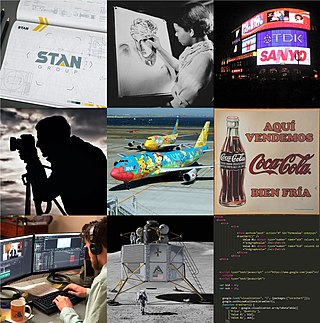Related Research Articles

Graphic design is a profession, academic discipline and applied art whose activity consists in projecting visual communications intended to transmit specific messages to social groups, with specific objectives. Graphic design is an interdisciplinary branch of design and of the fine arts. Its practice involves creativity, innovation and lateral thinking using manual or digital tools, where it is usual to use text and graphics to communicate visually.

A role-playing game is a game in which players assume the roles of characters in a fictional setting. Players take responsibility for acting out these roles within a narrative, either through literal acting or through a process of structured decision-making regarding character development. Actions taken within many games succeed or fail according to a formal system of rules and guidelines.
A storytelling game is a game where multiple players collaborate on telling a spontaneous story. Usually, each player takes care of one or more characters in the developing story. Some games in the tradition of role-playing games require one participant to take the roles of the various supporting characters, as well as introducing non-character forces, but other systems dispense with this figure and distribute this function among all players.
An alternate reality game (ARG) is an interactive networked narrative that uses the real world as a platform and employs transmedia storytelling to deliver a story that may be altered by players' ideas or actions.
Video game design is the process of designing the content and rules of video games in the pre-production stage and designing the gameplay, environment, storyline and characters in the production stage. Some common video game design subdisciplines are world design, level design, system design, content design, and user interface design. Within the video game industry, video game design is usually just referred to as "game design", which is a more general term elsewhere.
Interactive storytelling is a form of digital entertainment in which the storyline is not predetermined. The author creates the setting, characters, and situation which the narrative must address, but the user experiences a unique story based on their interactions with the story world. The architecture of an interactive storytelling program includes a drama manager, user model, and agent model to control, respectively, aspects of narrative production, player uniqueness, and character knowledge and behavior. Together, these systems generate characters that act "human," alter the world in real-time reactions to the player, and ensure that new narrative events unfold comprehensibly.
Narratology is the study of narrative and narrative structure and the ways that these affect human perception. It is an anglicisation of French narratologie, coined by Tzvetan Todorov. Its theoretical lineage is traceable to Aristotle (Poetics) but modern narratology is agreed to have begun with the Russian formalists, particularly Vladimir Propp, and Mikhail Bakhtin's theories of heteroglossia, dialogism, and the chronotope first presented in The Dialogic Imagination (1975).
Emergent gameplay refers to complex situations in video games, board games, or table top role-playing games that emerge from the interaction of relatively simple game mechanics.
Digital storytelling is a short form of digital media production that allows everyday people to create and share their stories online. The method is frequently used in schools, museums, libraries, social work and health settings, and communities. They are thought to have educational, democratizing and even therapeutic effects.

Façade is an artificial intelligence-based interactive story created in 2005 by Michael Mateas and Andrew Stern. Upon release, the game received attention from mainstream news publications for its innovative design, and prompted speculation about the potential use of artificial intelligence in video games. Following release, Façade has received a generally positive reception, with praise directed at its technical innovation and wide cultural appeal, particularly in online streaming, and mixed views directed to the verisimilitude of its representation of interpersonal interaction.

Brenda Laurel is an American interaction designer, video game designer, and researcher. She is an advocate for diversity and inclusiveness in video games, a "pioneer in developing virtual reality", a public speaker, and an academic.
User experience design is the process of defining the experience a user would go through when interacting with a company, its services, and its products. Design decisions in UX design are often driven by research, data analysis, and test results rather than aesthetic preferences and opinions. Unlike user interface design, which focuses solely on the design of a computer interface, UX design encompasses all aspects of a user's perceived experience with a product or website, such as its usability, usefulness, desirability, brand perception, and overall performance. UX design is also an element of the customer experience (CX), which encompasses all aspects and stages of a customer's experience and interaction with a company.

Immersive design describes design work which ranges in levels of interaction and leads users to be fully absorbed in an experience. This form of design involves the use of VR, AR, and MR that creates the illusion that the user is physically interacting with a realistic digital atmosphere.

A sandbox game is a video game with a gameplay element that provides players a great degree of creativity to interact with, usually without any predetermined goal, or alternatively with a goal that the players set for themselves. Such games may lack any objective, and are sometimes referred to as non-games or software toys. More often, sandbox games result from these creative elements being incorporated into other genres and allowing for emergent gameplay. Sandbox games are often associated with an open world concept which gives the players freedom of movement and progression in the game's world. The term "sandbox" derives from the nature of a sandbox that lets children create nearly anything they want within it.
An adventure game is a video game genre in which the player assumes the role of a protagonist in an interactive story, driven by exploration and/or puzzle-solving. The genre's focus on story allows it to draw heavily from other narrative-based media, such as literature and film, encompassing a wide variety of genres. Most adventure games are designed for a single player, since the emphasis on story and character makes multiplayer design difficult. Colossal Cave Adventure is identified by Rick Adams as the first such adventure game, first released in 1976, while other notable adventure game series include Zork, King's Quest, Monkey Island, Syberia, and Myst.

Game design is the process of creating and shaping the mechanics, systems, and rules of a game. Games can be created for entertainment, education, exercise, or experimental purposes. Increasingly, elements and principles of game design are also applied to other interactions, in the form of gamification. Game designer and developer Robert Zubek defines game design by breaking it down into its elements, which he says are the following:

The Beginner's Guide is an interactive storytelling video game created by Davey Wreden under the studio name Everything Unlimited Ltd. The game was released for Linux, OS X, and Windows on October 1, 2015. The game is Wreden's follow-up to the critically praised The Stanley Parable, his previous interactive storytelling title that was initially released in 2013.
Flavia Sparacino is an American-based space maker and scientist. She is currently CEO/Founder of Sensing Places, a MIT Media Lab spinoff that specializes in immersive space design and technology.
Video game writing is the art and craft of writing scripts and narratives for video games. Similar to screenwriting, it is typically a freelance profession. It includes many differences from writing for film, due to the non-linear and interactive nature of most video games, and the necessity to work closely with video game designers and voice actors. There are many differing types of text in video games in comparison to stage shows or movies, including written text, foreign or made-up languages, and often situation-based information. Especially when developing Triple A games, more than one writer will be required to create the game, split into different roles.

Secret Story Network is an online interactive storytelling experience which operates live role-playing games. Hosted over WhatsApp, SSN was created in 2017 by film, multimedia, and transmedia artist Krishna Stott, creative developer at Bellyfeel, and known for the earlier award-winning interactive film projects Crimeface (2008) and Bolton Storyworld: Codename Winterhill (2016).
References
- ↑ "Writing and Narrative Design: A Relationship" – via www.youtube.com.
- ↑ Batchelor, James (2021). "How to get a job as a narrative director", gamesindustry.biz article.
- ↑ Suckling, Maurice (2012). Video game writing : from macro to micro. Dulles, Va.: Mercury Learning and Information. p. 85. ISBN 9781936420155.
- ↑ "What is a Narrative Designer?". Game Developer. 2011-09-14. Retrieved 2023-04-23.
- ↑ Studio Spotlight - Expert Narrative Designer , retrieved 2023-04-23
- ↑ Bell, Madison Smartt. Narrative Design: A Writer's Guide to Structure, W.W. Norton, 1997
- ↑ Grimaldi, Silvia; Fokkinga, Steven; Ocnarescu, Ioana (2013). "Narratives in design: A study of the types, applications and functions of narratives in design practice". Proceedings of the 6th International Conference on Designing Pleasurable Products and Interfaces. pp. 201–210. doi:10.1145/2513506.2513528. ISBN 9781450321921. S2CID 28074874.
- ↑ Murphy, Christopher. "Narrative Design: Principles of UX Design Pt. 3". Adobe XD Ideas. Adobe. Retrieved 9 August 2021.
- ↑ Liestoel, Gunnar (2019-12-18). Augmented Reality Storytelling – Narrative Design and Reconstruction of a Historical Event in situ. International Association of Online Engineering.